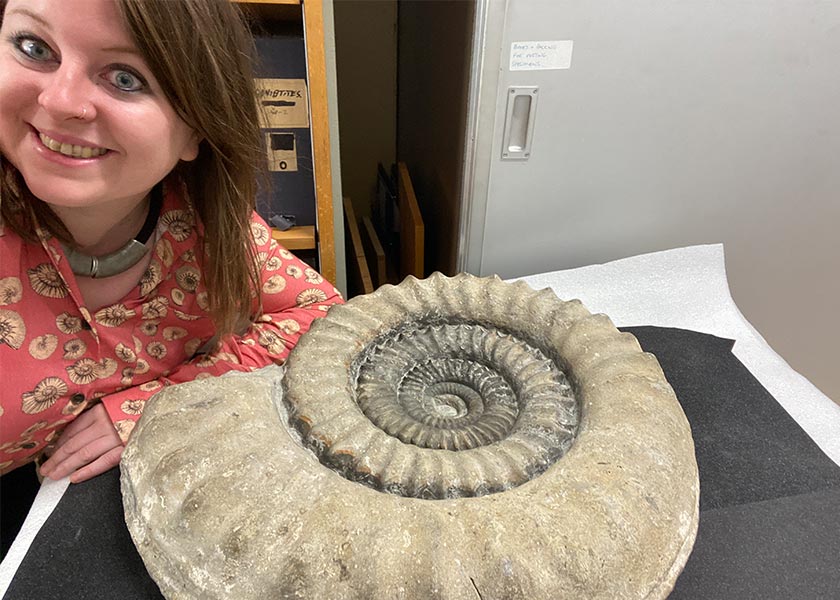Natural History Museum X Joanie: Q&A with Zoe Hughes, Senior Curator of Brachiopods and Fossil Cephalopods
In celebration of the Natural History Museum X Joanie collection, we're sitting down with some of the female scientists working at the Museum across an array of fields to learn more about what got them into science and their careers so far!
This week, we're talking to Zoe Hughes, Senior Curator of Brachiopods and Fossil Cephalopods
Hi Zoe! Can you tell us a bit about your specific area of study or interest?
I’m the senior curator of Brachiopods and Fossil Cephalopods at the Museum, and I'm responsible for 9000 drawers of specimens. I’m interested in the taxonomy of a group of brachiopods called Rhynchonellids. I’m also very passionate about outreach and sharing the wonders of both cephalopods and brachiopods with the world!
One of my favourite jobs at the Museum is the science show I do - Dinosnores for Kids and Dinosnores for grown-ups (it’s quite different between the two!). Day-to-day, I am responsible for the care and access of the collection. We host scientists from all over the world researching the collections. Currently, I’m imminently about to host an international symposium of cephalopod workers at the Museum.
What has your career looked like so far, and what drew you to the Natural History Museum?
I started volunteering at the Museum in 2010 when I was doing my Masters at Imperial College, but based at the NHM. Since then, I have gradually worked my way up, starting as a Temporary Collections Care Assistant and then becoming a Maternity Cover Curator before starting as Curator of the Brachiopods and Fossil Cephalopods. Since then, I have been involved in a range of projects across the Museum and have recently been promoted to Senior Curator. I think much of my career has been a case of having the right skills and being very lucky to be in the right place at the right time! I never dreamed that I would one day be a curator at the NHM when I was growing up.
What inspired you to get into science - is it something you’ve always been interested in, or was there something or someone specifically that influenced your decision to pursue a career in STEM?
I have always loved science. Whether I preferred biology, chemistry, or physics changed throughout school, in part dependent upon my teacher. My GCSE biology teacher Mr Phillips definitely help cement my interest in biological sciences. I also collected a magazine called 'Treasures of the Earth' where you'd get a mineral and a polished gem specimen every week. Strangely, it never occurred to me to go to University to study geology! My cousin was also an inspiration - she taught me how to use my first microscope one Christmas. I wanted to get a Ph.D. like her when I was growing up.
What would you say are the major challenges as a woman working in a scientific field?
People not believing that you are a scientist! People perceive Palaeontology, especially, as a profession for older, bearded gentlemen who wear multipocketed waistcoats! I am keen to inspire people to become scientists, and it's particularly important to me to encourage people from working-class backgrounds to work in science. If my mum were still around, I hope she would be amazed and proud of where I work and how far I’ve come from my childhood.
What advice would you give to aspiring young scientists - especially young girls - who might feel daunted by the prospect of scientific study?
Go for it! Read what interests you and go and explore. When you’re doing work experience, find a placement in a scientific institution (I did mine at the Oral Pathology labs at Guy's Hospital - fascinating!). If you want to work in a Museum, volunteer to get some experience.
What’s the most exciting thing about your job?
That is an exceptionally hard question to answer! I’ve had David Attenborough filming in the Cephalopod collections, which was a particular highlight. I also love to travel - going to do fieldwork in Morocco was a highlight, as was visiting China for a conference.
Being part of the team digging up the amazing crinoids in Wiltshire last year was amazing - I got to be on the BBC news and Blue Peter. Getting a Blue Peter badge definitely made me regress to being six again!
Having scientists from all over the world come to use the collections and collaborating with them is amazing.
At a more simple (but still amazing) level, going out into the collection and finding incredible specimens collected by people like Charles Darwin or discovered in places I can only dream of going. It’s inspiring every day. Plus, I get to learn every day, which I adore!
Shop the Natural History Museum X Joanie collection now, exclusively at Joanie Clothing!








